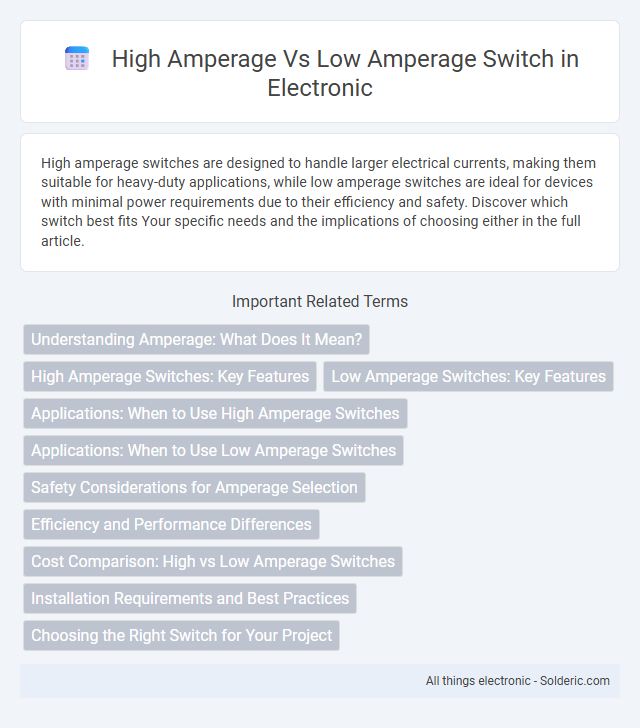High amperage switches are designed to handle larger electrical currents, making them suitable for heavy-duty applications, while low amperage switches are ideal for devices with minimal power requirements due to their efficiency and safety. Discover which switch best fits Your specific needs and the implications of choosing either in the full article.
Comparison Table
| Feature | High Amperage Switch | Low Amperage Switch |
|---|---|---|
| Current Capacity | Above 30 Amps | Below 10 Amps |
| Use Case | Heavy machinery, industrial equipment | Small appliances, electronics |
| Size | Larger, robust construction | Compact, lightweight |
| Durability | High durability for frequent, intense use | Moderate durability for light use |
| Cost | Higher cost due to materials and capacity | Lower cost, suitable for budget devices |
| Heat Dissipation | Effective heat management required | Minimal heat generation |
Understanding Amperage: What Does It Mean?
Amperage, measured in amperes (amps), represents the amount of electrical current flowing through a switch, directly affecting its capacity to handle electrical loads safely. High amperage switches are designed to manage heavy current flows without overheating or failure, making them suitable for industrial or high-power applications, while low amperage switches are ideal for lighter electrical loads typically found in household devices. Understanding the amperage rating helps you select the appropriate switch to ensure optimal performance and safety in your electrical projects.
High Amperage Switches: Key Features
High amperage switches are designed to handle large electrical currents, often exceeding 30 amps, making them suitable for industrial machinery and heavy-duty applications. These switches feature robust contacts made from durable materials such as silver alloy to ensure reliable conductivity and resist arcing under high load conditions. Your system benefits from enhanced safety and longevity due to their heat-resistant construction and superior electrical performance.
Low Amperage Switches: Key Features
Low amperage switches are designed to handle currents typically below 5 amperes, making them ideal for delicate electronic circuits and signaling applications. These switches provide precise control with minimal power loss and are often found in devices requiring energy efficiency and safety, such as control panels and communication equipment. Their compact size and low thermal output ensure reliable performance in sensitive environments without risking circuit damage.
Applications: When to Use High Amperage Switches
High amperage switches are essential in industrial machinery, electric vehicle systems, and power distribution networks where large current flows exceed 30 amps. These switches provide the durability and safety needed to manage heavy electrical loads without overheating or damage. Low amperage switches, typically rated below 15 amps, are suitable for consumer electronics and small appliances where current demands are minimal.
Applications: When to Use Low Amperage Switches
Low amperage switches are ideal for applications where control of small electrical loads or signal circuits is required, such as in electronics, telecommunications, and low-power LED lighting systems. Your devices benefit from precise switching without the risk of damage caused by high current, making low amperage switches perfect for sensitive equipment and microcontroller projects. They effectively manage currents typically under 5 amps, ensuring safety and efficiency in delicate or battery-powered operations.
Safety Considerations for Amperage Selection
Selecting the appropriate amperage for a switch is critical for ensuring electrical safety and preventing circuit overloads. High amperage switches are designed to handle greater currents without overheating, reducing the risk of fire hazards, while low amperage switches must be used within their rated limits to avoid damage or electrical shock. Proper amperage selection aligns with the electrical load requirements and compliance with safety standards such as UL (Underwriters Laboratories) to maintain system reliability and operator protection.
Efficiency and Performance Differences
High amperage switches excel in efficiency by minimizing power loss and heat generation during operation, ensuring robust performance in demanding electrical circuits. Low amperage switches are optimized for lighter loads, offering quicker response times and greater precision but may suffer efficiency losses and reduced durability under high current conditions. Selecting the appropriate switch based on amperage requirements significantly impacts overall system reliability and energy consumption.
Cost Comparison: High vs Low Amperage Switches
High amperage switches generally cost more due to their robust design and ability to handle greater electrical loads, making them suitable for heavy-duty industrial applications. Low amperage switches are less expensive, ideal for residential or lighter commercial use where current demands are lower. Choosing the right switch depends on your specific power requirements and budget constraints, ensuring optimal performance without unnecessary expenses.
Installation Requirements and Best Practices
High amperage switches require robust wiring with thicker gauge cables to handle increased current flow safely, minimizing voltage drop and heat generation during installation. Low amperage switches use thinner wires and simpler circuitry, demanding less stringent insulation and mounting clearances. Best practices for high amperage switch installation include securing connections with torque-appropriate terminals, implementing proper heat dissipation methods, and adhering strictly to electrical codes to prevent overload risks.
Choosing the Right Switch for Your Project
Selecting the right switch for your project depends on the current requirements, with high amperage switches designed to handle heavy electrical loads and low amperage switches suited for lighter circuits. High amperage switches, rated for currents typically above 15 amps, ensure safety and durability in industrial machinery or large appliances, preventing overheating and electrical failures. Low amperage switches, usually rated below 15 amps, are ideal for electronics and smaller household devices, offering precise control without the risk of overload.
high amperage vs low amperage switch Infographic

 solderic.com
solderic.com